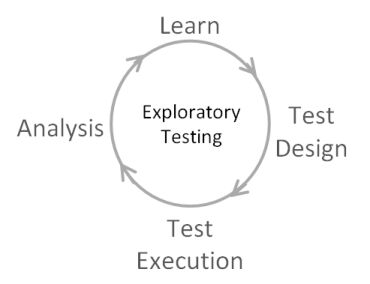What is Exploratory Testing
This testing is similar to the ad-hoc testing and is done in order to learn/explore the application. It si shortly known as ET.
Exploratory software testing is a powerful and fun approach to testing. View the pdf tutorials about Exploratory Testing. In some situations, it can be orders of magnitude more productive than scripted testing. At least unconsciously, testers perform exploratory testing at one time or another. Yet it doesn’t get much respect in our field. It can be considered as “Scientific Thinking” at real time.

Exploratory testing is the act of exploring, making discoveries about the software, whether it works or not, the type of job it does and what it doesn’t do. The tester keeps making a new decision based on what are discovered during the course of the test. This is normally thought of as a black box testing technique.
What is exploratory testing?
Exploratory testing was first defined in 1984 by Cem Kaner, as “a style of software testing that emphasizes the personal freedom and responsibility of the individual tester to continually optimize the quality of his/her work by treating test-related learning, test design, test execution, and test result interpretation as mutually supportive activities that run in parallel throughout the project.”
Advantages of exploratory testing
Exploratory testing comes with some advantages which are highlighted below.
- Testers can guide their future testing by making use of deductive reasoning derived from previous results. It is not mandatory that a current series of scripted tests must be completed before advancing to explore a rich environment that is more targeted. When intelligently used, this can help to speed up the process of detecting more bugs.
- Another advantage is that it requires less preparation, it is easy to discover important bugs, and the approach has the tendency to be more intellectually stimulating than scripted tests execution at the time of execution.
- One other advantage is that most bugs are detected by exploratory testing after the initial testing has been done. It simply helps to detect bugs that escaped being seen during the initial testing.
- Exploratory testing is useful in that, when a bug is discovered, it can be used to explore the size, variations, and scope of the bug in order to supply adequate feedback to the developers.
- Exploratory testing is useful in dynamic product environment when the product is at its early stage of development, undergoing changes, or the product is unstable. This is particularly made possible because exploratory testing approach needs less documentation or no documentation at all before testing activities are commenced.
- It provides simultaneous learning. While automated tests assist in executing checks/tests swiftly, humans are able to learn from the tests conducted and come up with different test scenarios.
Disadvantages of Exploratory Testing
Exploratory testing is not without one or two disadvantages. Here are a few of the disadvantages to take note of.
- It is impossible to review in advance tests invented and performed on the fly, and it is also hard to give an idea about the exact tests that have been run.
- When revisited, freestyle exploratory test ideas are not likely to be performed in exactly the same way, making it a disadvantage if it is important that the specific details of the earlier tests are to be repeated.
Conclusion
The importance of exploratory testing cannot be overemphasized. Exploratory testing requires testers with an analytical mindset, who are able to know what to test for and how to analyze the results, even though the tests are carried out by automated software.
